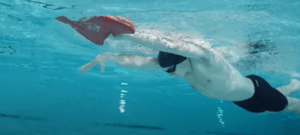Teach swimmers to take less freestyle strokes with this one easy drill.
Coaches often look for the best drills to improve their swimmers’ strokes and swimming ability. Building the proper stroke foundation allows swimmers to progress much faster than they would with poor technique. Here is the best drill to teach swimmers to take less freestyle strokes.
But isn’t it faster to take more strokes?
The number one goal of swimming is to finish the race as fast as possible. Typically when people think of swimming, they envision that super fast race where the swimmers swim one length of the pool. Tons of splashing, big kicks, and almost no breathing characterizes this style of race. But, try to watch even the best of swimmers keep that speed up for more than another lap and you will see them slow down exponentially.
No swimmer can keep up a fast arm tempo for very long. That is why, for practices and long races, it is important that new swimmers build a strong freestyle. You can’t rely on moving your arms fast the whole time…you need a good stroke.
What’s the best freestyle drill to help take less strokes?
The number one drill to teach swimmers to take less freestyle strokes is a drill called catchup. This drill feels like you are swimming freestyle normally but with one catch–you must hold your arm above your head until the other arm touches it. This pause out in the front of the freestyle stroke teaches swimmers to get a good grip on the water before they forcefully pull the water toward the feet.
Catchup teaches swimmers where to catch the water during their stroke, builds a good core from the rotation of the arms, and builds shoulder stability.
Drill progression one: kickboard
For young swimmers, it is important to give them something physical to touch while they begin to learn the proper drill…it’s hard for children around ten and under to change their strokes just by thinking about them. Give each swimmer a kickboard and have them hold it out front, just like regular kick, with their face in the water. Then, take one hand at a time and take a stroke, finishing by grabbing the bottom of the board. The opposite hand will continue to hold onto the board during the stroke. As soon as your hand finishes, take the other and repeat. To breathe, swimmers should turn their head toward the side that the arm is taking a stroke.
The first time the drill is introduced, the focus should be entirely on the arms and breathing to the site. Once swimmers begin to understand what their arms should be doing, encourage them to focus on getting a good, strong kick all throughout the drill.
Drill progression two: diving stick
As this becomes easier, you can upgrade to a diving stick so you must focus on stabilizing your body to keep afloat. Instead of holding the kick board out in front, swimmers will hold a straight diving stick. The diving stick still gives young swimmers something to visualize during the progression but removes the buoyancy help provided by the kickboard. It is important to make sure swimmers don’t drop their leading arm! It should stay out in front the whole time to build the strength of the core and to get the right catch.
At this point, the catchup drill starts to build the proper technique; the kickboard drill just helps understand the drill better. Continue to focus on a strong kick to keep the body in the right position!
Drill progression three: regular freestyle
When this gets easy enough, do the drill with zero equipment–just have swimmers hold their hand in front of their head until the next comes around…same thing just without the diving stick. Focus not only on holding the arm out in front, but also encourage the head to stay stationary looking straight at the bottom. This builds the proper stability in your arms and your core as you rotate your shoulders to facilitate each stroke. Read my other blog explaining why rotation is important in each stroke.
Watch this video by Speedo that gives a good catchup demonstration. Notice the rotation from the shoulders but the head stays still:
The catchup drill allows new swimmers to build stabilization and learn a strong, proper stroke to allow them to take less strokes during their freestyle. In my opinion, catchup is the number one drill to teach proper freestyle technique to new swimmers because of how much of the stroke it can improve. It may take time to see results, but forming this technique foundation is vital for all swimmers.
Interested in learning other freestyle drills, including some drill progressions? Check out my list of seven beginner freestyle drills.

